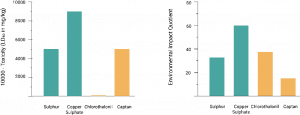There is so much pseudoscience being spread around nowadays, and sometimes it can be hard to spot, especially for those who don’t have a background in science. A lot of it is based on a small amount of truth and by people who you may think you can trust, so it can be difficult to differentiate from good, truthful science.
These five basic scientific concepts can help you to spot pseudoscience when you see it:
#1) Everything is made of chemicals
You are made up of chemicals, and everything you eat is made up of chemicals. This series of posters by James Kennedy illustrates how all natural fruits are made up entirely of chemicals, some that may even have names you can’t pronounce and don’t recognize:
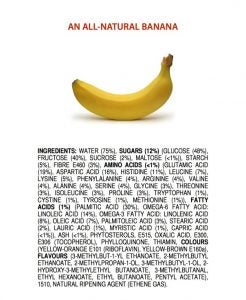
A “chemical free lifestyle” is impossible. Water and oxygen are examples of chemicals that you need to survive, and you wouldn’t last very long without them. So, the next time you see a food product that purports to contain “no chemicals” or a blog with products that you can purchase to live a “chemical-free lifestyle,” you can be sure that it’s purely pseudoscience because EVERYTHING IS MADE UP OF CHEMICALS.
#2) The dose makes the poison
“Toxic” is a word thrown around a lot on food blogs and in food marketing, but it’s almost always used incorrectly. There is no such thing as a “toxic chemical,” there are only toxic doses. The phrase “the dose makes the poison” applies to all chemicals, both natural and synthetic.
Acute toxicity measures lethal effects from a large one-time dose and is expressed as the LD50. The LD50, or median lethal dose, is determined experimentally, usually with rats or mice. It is the single acute dose that will kill 50 percent of a population given that dose. Chronic toxicity measures the lowest level of daily exposure that causes harm. Any chemical can be toxic, even water and salt, so products that state things like “no toxic chemicals” or “no toxic pesticides” don’t make any sense as every chemical can be toxic at a large enough dose. And, if someone tries to tell you that a food ingredient or a chemical is “toxic” without being able to tell you the concentration at which the chemical occurs in the food and the dose that is toxic, they either have no idea what they’re talking about, are trying to deceive you, and/or are trying to sell you something.
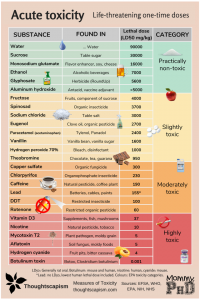
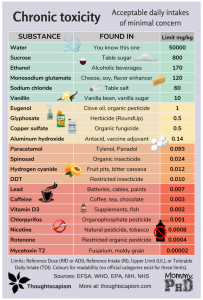
#3) Whether a chemical is natural or synthetic tells you precisely nothing about its safety
As stated previously, “the dose makes the poison” applies to both natural and synthetic chemicals, so whether a chemical is natural or man-made tells you precisely nothing about how dangerous it is. For example, sodium thiopenta, a man-made chemical, is used in lethal injections, but it’s about as toxic as naturally occurring amygdalin, which is contained in almonds and apple seeds. Similarly, many natural and organic pesticides have a lower toxic dose than their synthetic counterparts.
The appeal to nature fallacy is the belief that is what is natural must be good, and that which is unnatural must be bad. “Natural” has no definition per the FDA in regards to food labeling, yet it’s used in food marketing all of the time. You can be sure to ignore anyone or any product that uses the word “natural” to mean better or safer as the “appeal to nature fallacy’ is just that, a fallacy. It’s pure pseudoscience.
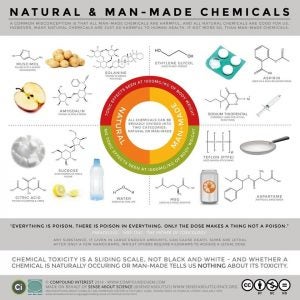
Here is a comparison between two organic fungicides (shown in teal) and two synthetic fungicides (shown in gold):
#4) Relative difference is not the same as absolute difference
It’s very important to understand relative difference vs. absolute difference when evaluating studies and food marketing claims. News outlets and researchers take advantage of the fact that many people don’t understand the difference between the two in order to publish attention grabbing headlines.
Here’s an example related to food: A 2013 study showed that “organic milk has 62% more omega-3 fatty acids than conventional milk.” That sounds significant, but it only tells us the relative percent increase between omega-3’s in organic milk vs. conventional milk. That information doesn’t mean much without knowing the actual values, the absolute increase, and whether the difference is significant or not. In this case, the difference is 25.5 mg omega-3’s/100g of organic milk vs. 15.9 mg omega-3’s/100g of conventional milk. So, that’s an absolute difference of 9.6 mg/100g. Considering that salmon contains about 2,260mg/100g and the recommendation is 250 to 500 mg/day, you can see that the 62 percent more claim is insignificant as milk isn’t even a significant source of omega-3’s to begin with.
This conversation illustrates this concept quite well:
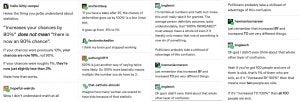
#5) The food you eat does not change the pH of your body
The food you eat DOES NOT affect the pH of your blood. If you’ve ever heard someone say that you can alkalize your body by eating certain foods, it’s completely false — which is a good thing, because if what you ate could change the pH of your blood, you would die. This great article by Registered Dietitian Abby Langer explains how the alkaline diet is based on complete pseudoscience. Our blood pH is tightly regulated by our kidneys, lungs, and our buffer system, which keeps the blood’s (i.e., body’s) pH between 7.35-7.45, and isn’t affected at all by what we eat. So, keep an eye out for products such as alkaline water that purport to have health benefits based on the fact that they’re alkaline. It’s purely based on pseudoscience and makes a complete mockery of basic physiology.
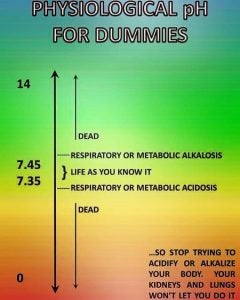
So, the next time you run across a questionable post on social media or a blog about how to live a chemical-free life, remember these basic scientific concepts and just say “NO” to pseudoscience!
Food Science Babe is the pseudonym of an agvocate and writer who focuses specifically on the science behind our food. She has a degree in chemical engineering and has worked in the food industry for more than decade, both in the conventional and in the natural/organic sectors.

